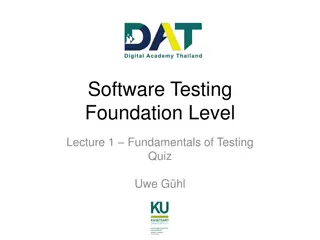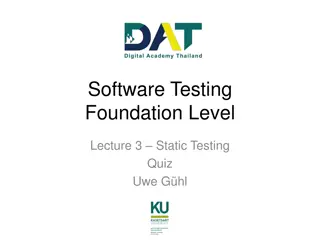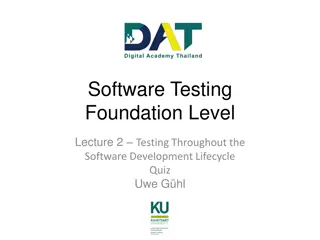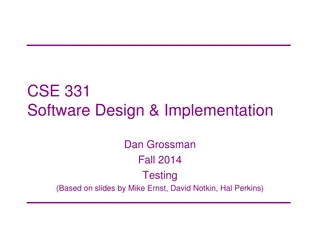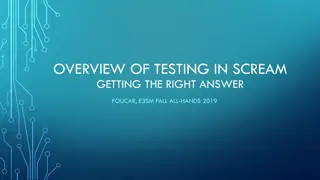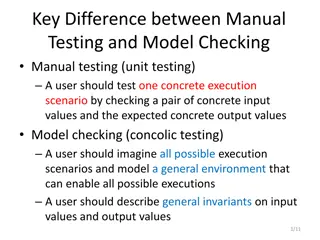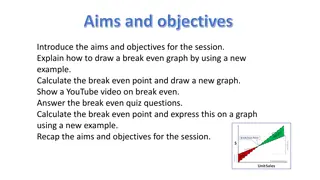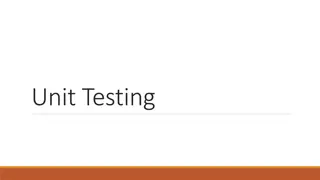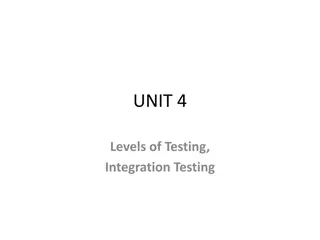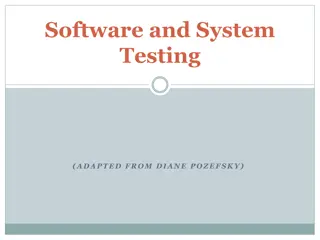Break & Quiz: Testing Knowledge on KDE and Model Training
Here's a quiz covering topics like Kernel Density Estimation (KDE) and model training. Test your understanding of KDE, probability distributions, and model optimization. Explore questions on KDE kernels, histogram representation, and training parameters in machine learning models.
Download Presentation

Please find below an Image/Link to download the presentation.
The content on the website is provided AS IS for your information and personal use only. It may not be sold, licensed, or shared on other websites without obtaining consent from the author.If you encounter any issues during the download, it is possible that the publisher has removed the file from their server.
You are allowed to download the files provided on this website for personal or commercial use, subject to the condition that they are used lawfully. All files are the property of their respective owners.
The content on the website is provided AS IS for your information and personal use only. It may not be sold, licensed, or shared on other websites without obtaining consent from the author.
E N D
Presentation Transcript
Break & Quiz Q 1.1: Which of the following is not true? A. Using a Gaussian kernel for KDE, all possible values for xiwill have non-zero probability. B. The goal of KDE is to approximate the true probability distribution function of X. C. When using a histogram, every bucket must be represented explicitly in memory D. With some kernels, KDE can assign zero probability to some subset of values for xi.
Break & Quiz Q 1.1: Which of the following is not true? A. Using a Gaussian kernel for KDE, all possible values for xiwill have non-zero probability. B. The goal of KDE is to approximate the true probability distribution function of X. C. When using a histogram, every bucket must be represented explicitly in memory D. With some kernels, KDE can assign zero probability to some subset of values for xi.
Break & Quiz Q 1.1: Which of the following is not true? A. Using a Gaussian kernel for KDE, all possible values for xiwill have non-zero probability. (Gaussian PDF positive for all inputs) B. The goal of KDE is to approximate the true probability distribution function of X. (same goal as histograms) C. When using a histogram, every bucket must be represented explicitly in memory D. With some kernels, KDE can assign zero probability to some subset of values for xi. (Consider K = uniform(0,1))
Break & Quiz Q 2.1: When we train a model, we are A. Optimizing the parameters and keeping the features fixed. B. Optimizing the features and keeping the parameters fixed. C. Optimizing the parameters and the features. D. Keeping parameters and features fixed and changing the predictions.
Break & Quiz Q 2.1: When we train a model, we are A. Optimizing the parameters and keeping the features fixed. B. Optimizing the features and keeping the parameters fixed. C. Optimizing the parameters and the features. D. Keeping parameters and features fixed and changing the predictions.
Break & Quiz Q 2.1: When we train a model, we are A. Optimizing the parameters and keeping the features fixed. B. Optimizing the features and keeping the parameters fixed) (Feature vectors xi don t change during training). C. Optimizing the parameters and the features. (Same as B) D. Keeping parameters and features fixed and changing the predictions. (We can t train if we don t change the parameters)
Break & Quiz Q 2.2: You have trained a classifier, and you find there is significantly higher loss on the test set than the training set. What is likely the case? A. You have accidentally trained your classifier on the test set. B. Your classifier is generalizing well. C. Your classifier is generalizing poorly. D. Your classifier is ready for use.
Break & Quiz Q 2.2: You have trained a classifier, and you find there is significantly higher loss on the test set than the training set. What is likely the case? A. You have accidentally trained your classifier on the test set. B. Your classifier is generalizing well. C. Your classifier is generalizing poorly. D. Your classifier is ready for use.
Break & Quiz Q 2.2: You have trained a classifier, and you find there is significantly higher loss on the test set than the training set. What is likely the case? A. You have accidentally trained your classifier on the test set. (No, this would make test loss lower) B. Your classifier is generalizing well. (No, test loss is high means poor generalization) C. Your classifier is generalizing poorly. D. Your classifier is ready for use. (No, will perform poorly on new data)
Break & Quiz Q 2.3: You have trained a classifier, and you find there is significantly lower loss on the test set than the training set. What is likely the case? A. You have accidentally trained your classifier on the test set. B. Your classifier is generalizing well. C. Your classifier is generalizing poorly. D. Your classifier needs further training.
Break & Quiz Q 2.3: You have trained a classifier, and you find there is significantly lower loss on the test set than the training set. What is likely the case? A. You have accidentally trained your classifier on the test set. (This is very likely, loss will usually be the lowest on the data set on which a model has been trained) B. Your classifier is generalizing well. C. Your classifier is generalizing poorly. D. Your classifier needs further training.


